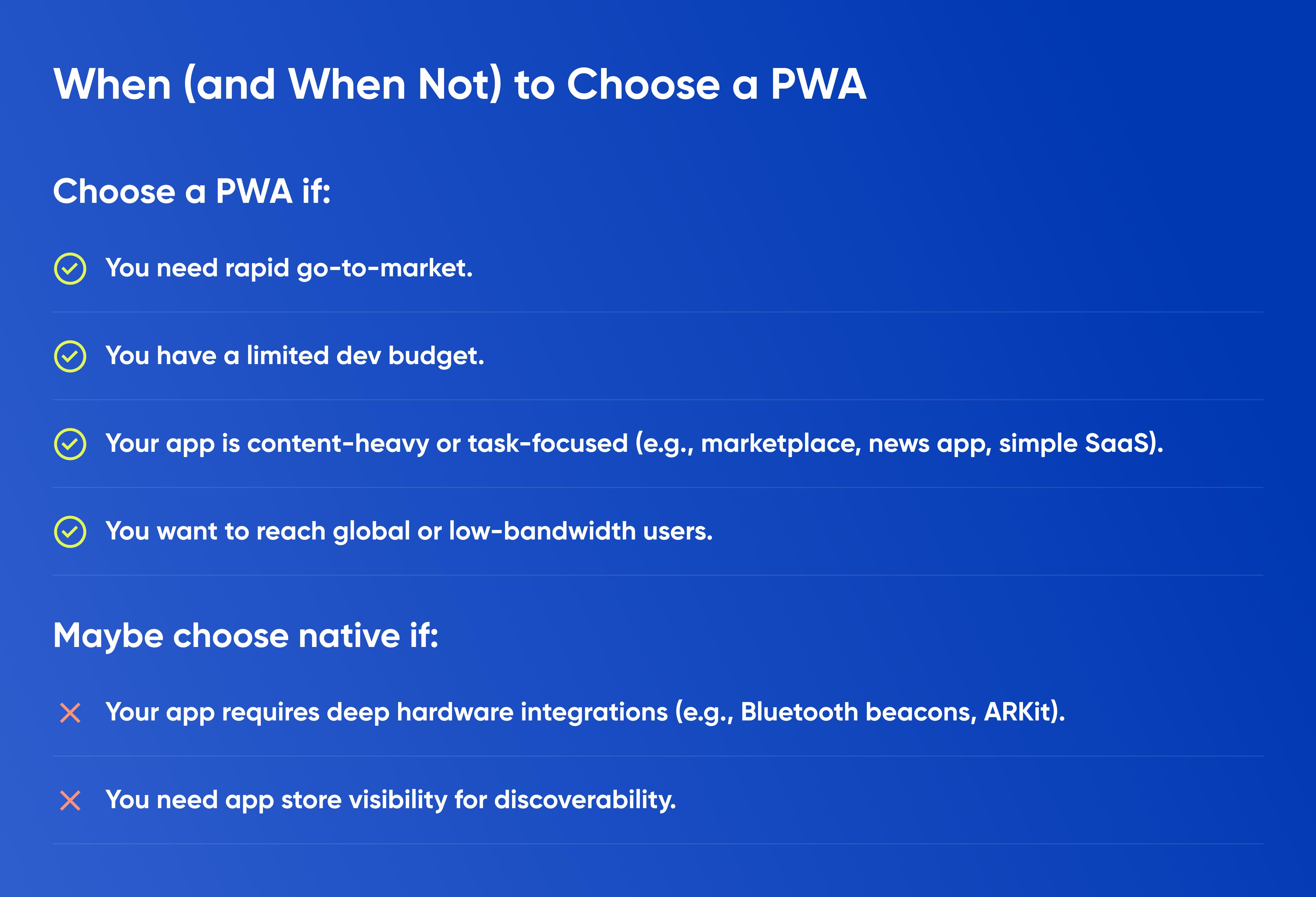What Is a Progressive Web App (PWA) — and Why Should You Care?
Startups today face a tough challenge: how do you deliver a top-notch mobile experience without sinking half your budget into app stores, native development teams, and endless update cycles?
Enter Progressive Web Apps (PWAs): the perfect bridge between web and mobile. PWAs are web applications that behave like native apps — you can install them on your home screen, use them offline, receive push notifications, and enjoy lightning-fast performance. But they’re built using regular web technologies (HTML, CSS, JavaScript), making them cheaper and faster to develop than traditional native apps.
In 2025, even with tech evolving rapidly, PWAs are more relevant than ever for startups that need agility, growth, and scalability. Whether you’re building an MVP, expanding into new markets, or trying to boost retention, understanding PWAs is crucial.
Key Benefits of PWAs for Startups
1. Lightning-Fast Development Cycles
Building a PWA usually takes half the time of developing separate native apps for iOS and Android. For a startup, this time savings is gold. Instead of juggling two codebases, dealing with App Store review delays, and managing multiple development teams, you ship faster — and iterate based on user feedback.
Real-world advantage: Imagine you launch your MVP as a PWA in three months instead of six. That’s three extra months to start acquiring users, tweaking features, and growing.
Startups that ship faster learn faster — and that’s how you win.
2. Massive Cost Savings
Let’s be blunt: native apps are expensive. Hiring iOS and Android developers, maintaining app store compliance, and constant updates can burn through your funding quickly.
PWAs eliminate the double cost of development while still delivering app-like experiences. With one web app that works across desktop and mobile, you focus your resources on user experience — not duplicating effort.
Typical cost savings: Up to 70% less than building two fully native apps.
For early-stage founders, that’s money you can reinvest into growth, marketing, or refining your product-market fit.
3. Faster, Smoother User Experiences
PWAs use advanced caching and service workers to load content instantly, even on slow networks. They feel smooth, fast, and responsive — just like a native app.
In a world where users abandon slow websites in under 3 seconds, speed is your silent growth weapon. Every second saved boosts your conversion rate.
Proof: According to Google, PWAs increase page loading speeds by an average of 63% compared to traditional mobile websites.
If your competitor’s app takes 5 seconds to load and yours takes 1, guess who users will stick with?
4. No Gatekeepers (Goodbye, App Stores)
Publishing to the Apple App Store or Google Play Store is notoriously slow and bureaucratic. You're subject to their rules, their review processes, their fees.
With a PWA, your users can install your app directly from your website — no app store needed. Updates happen automatically behind the scenes. No waiting for approval. No wondering if a policy change will suddenly ban your app.
You own the relationship with your users. Full control. Full flexibility.
5. Offline Access & Push Notifications
PWAs can function offline or on flaky networks by caching content and data. They can also send push notifications — one of the most powerful tools for re-engaging users — just like a native app.
That means better retention, more reactivations, and deeper user engagement.
Quick stat: Push notifications have a 30%+ opt-in rate for PWAs (compared to 5-10% for email newsletters). If you’re building a product that depends on returning users (think e-commerce, SaaS, or content platforms), PWAs are a no-brainer.
Who’s Winning With PWAs Right Now?
Major brands (and startups) are already betting big on PWAs:
-
Pinterest: Their PWA led to a 40% increase in time spent by users and a 60% rise in core engagements.
-
Uber: Uber’s PWA loads in under 3 seconds even on 2G networks, allowing the company to expand into low-connectivity markets.
-
Spotify: Their web player PWA offers a fast, seamless music experience without downloading anything.
These giants could afford full native apps — but they know PWAs deliver better reach, faster updates, and bigger engagement wins.
If it’s good enough for Spotify and Uber, it’s a killer move for agile startups too.
Common PWA Myths (Debunked!)
🚫 "PWAs are slower than native apps." ➔ Not true. With smart caching and modern service workers, PWAs can match or beat native speed.
🚫 "PWAs can't access hardware features." ➔ They can access geolocation, camera, microphone, offline storage, push notifications, and more — and the list keeps expanding every year.
🚫 "Users won’t install web apps." ➔ Wrong. Installing a PWA is frictionless. No big download. No permissions gauntlet. Just a simple "Add to Home Screen" prompt — and it works.
When (and When Not) to Choose a PWA

In many cases, smart startups launch as PWAs first to validate the market, then later invest in full native apps once they scale.
The Bottom Line
In 2025, Progressive Web Apps aren’t a compromise — they’re a strategic advantage. They let you build faster, spend less, reach more users, and grow on your own terms. In a world where agility wins, startups betting on PWAs are setting themselves up to dominate.
Thinking about launching your own PWA? At Movadex, we specialize in building lightning-fast, scalable, beautiful Progressive Web Apps that help startups go to market — and win.




